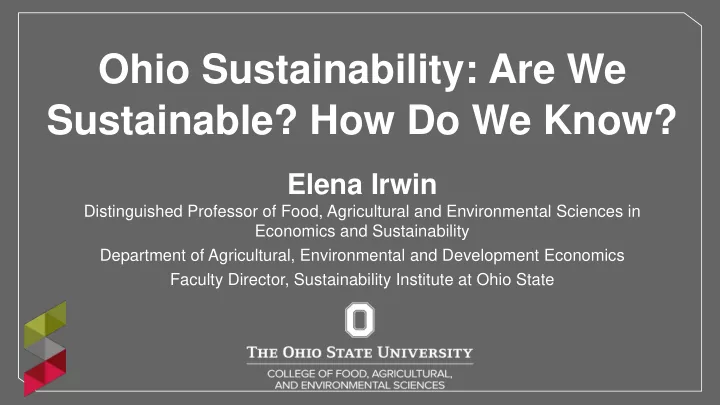

Ohio Sustainability: Are We Sustainable? How Do We Know? Elena Irwin Distinguished Professor of Food, Agricultural and Environmental Sciences in Economics and Sustainability Department of Agricultural, Environmental and Development Economics Faculty Director, Sustainability Institute at Ohio State
Illustrating the Global Sustainability Challenge Global material extraction Global primary energy consumption Sustainability Institute
Illustrating the Global Sustainability Challenge GDP per capita Global poverty rate Source: World Bank Sustainability Institute
Illustrating the Global Sustainability Challenge Annual total CO2 emissions by world region Source: IPBES (2019) Sustainability Institute
Illustrating the Global Sustainability Challenge World Population Sustainability Institute
What is sustainable development? The Brundtland Commission Report, Our Common Future (1987) “ development that meets that needs of the present without compromising the ability of future generations to meet their own needs …. At a minimum, sustainable development must not endanger the natural systems that support life on earth. ” + Intergenerational Equity + Earth ’ s life support systems Development = Intergenerational Human Well-Being Sustainability Institute
SSN 1476-4687 (online) 1. Strong sustainability (SS) Human well-being is subject to physical & ecological limits • Minimum levels of ecosystem regulating services, e.g., soil organic carbon, pollinator diversity, climate regulation • Maximum sustainable yields of renewable resources, e.g., fishing, deforestation • Maximum rates of pollution, e.g., GHG emissions, nutrient run-off Development that meets biophysical limits Source: Nature (online) ISSN 1476-4687 Sustainability Institute
SSN 1476-4687 (online) 2. Sustainability indicators • Representing the three pillars: environment, economy, society • Example: United Nations Sustainable Development Goals – 17 goals, 169 targets – Each target is measured by one or more indicators Development that meets sustainability targets Sustainability Institute
Example: Regional Sustainability Framework https://www.morpc.org/sustainabilityreportcard Energy Natural Economic Sustainable Regional consumption resources opportunity neighborhoods collaboration 7 6 2 6 2 objectives & objectives & objectives & objectives & objectives & targets targets targets targets targets Sustainability Institute
3. Weak sustainability (WS) • Human well-being is dependent on its “productive base” = inclusive (or comprehensive) wealth • Inclusive wealth = social value Value of of all capital assets in society Value of Value of Inclusive Manufactured Human Natural wealth capital capital capital Development that https://www.unenvironment.org/resources/report/inclusive-wealth-report-2018 maintains inclusive wealth over time Sustainability Institute
Applications of strong and weak sustainability to Ohio: Are Ohio’s lands sustainable? Sustainability Institute
Strong sustainability example: Do Ohio’s agricultural lands meet the 40% phosphorus reduction targets? Strong sustainability goals: Maumee Western Maumee Watershed Lake Erie Dissolved River 40% of Reactive P 186 MT Watershed 2008 (DRP) 40% of Total P (TP) 860 MT 2008 2015 Great Lakes Water Quality Agreement Protocol, Annex 4 Spring (March-July) Targets Sustainability Institute
Measured data average 2005-2014 Scavia et al. (2017) Front. Ecol. Environ Cropland to grassland on targeted 25% Cropland to grassland on targeted 50% Nutrient management on 100% Series of practices on targeted 50% Series of practices on random 50% Wetlands & buffer strips on targeted 50% Sustainability Institute
Measured data average 2005-2014 Scavia et al. (2017) Front. Ecol. Environ Cropland to grassland on targeted 25% What are the trade- Cropland to grassland on targeted 50% offs of meeting these land use & Nutrient management on 100% management targets? Series of practices on targeted 50% Series of practices on random 50% Wetlands & buffer strips on targeted 50% Sustainability Institute
Weak sustainability example: Changes in the Inclusive Wealth Index (IWI) for Ohio* Inclusive Wealth vs. GDP (in Billions 2016 USD) Total %Annual Change Change Capital Stock 2001 2016 (2001-2016) (2001-2016) -2.23 Natural: Exhaustible Resources 5.8 3.57 -2.56% Natural: Land (Forest, Cropland, -1.23 Pasture) 167.62 166.39 -0.05% 155.41 Manufactured: Non-Residential 606.13 761.54 1.71% 68.14 Manufactured: Residential 463.67 531.81 0.98% Human 1,269.4 1,344.13 74.73 0.39% 294.82 IWI 2,512.62 2,807.44 0.78% Real GDP 518.28 622.84 104.56 1.34% * Excludes a full accounting of ecosystem service losses due to land use changes and damages from manufacturing and natural resource extraction Sustainability Institute
Weak sustainability example: Changes in the Inclusive Wealth Index (IWI) for Ohio* Inclusive Wealth vs. GDP (in Billions 2016 USD) Total %Annual Change Change What are the biophysical limits Capital Stock 2001 2016 (2001-2016) (2001-2016) or ecological thresholds? -2.23 Natural: Exhaustible Resources 5.8 3.57 -2.56% Natural: Land (Forest, Cropland, -1.23 Pasture) 167.62 166.39 -0.05% What about future 155.41 Manufactured: Non-Residential 606.13 761.54 1.71% sustainability targets? 68.14 Manufactured: Residential 463.67 531.81 0.98% Human 1,269.4 1,344.13 74.73 0.39% 294.82 IWI 2,512.62 2,807.44 0.78% Real GDP 518.28 622.84 104.56 1.34% * Excludes a full accounting of ecosystem service losses due to land use changes and damages from manufacturing and natural resource extraction Sustainability Institute
Are Ohio’s lands sustainable? • Simplistic answer = NO • However this ignores trade-offs • IWI: considering trade-offs, we are weakly sustainable BUT with important caveats • Advantage of setting SS limits: A “safety first” approach given substantial uncertainty regarding biophysical limits Sustainability Institute
Towards a more comprehensive assessment: Weak Sustainability Plus = non-declining inclusive wealth WS+ + strong sustainability limits as needed Irwin, Gopalakrishnan, Randall. 2016. “Welfare, wealth, sustainability.” Annual Review of Resource Economics. 8:77–98. https://www.annualreviews.org/doi/pdf/10.1146/annurev-resource-100815-095351 Irwin, Bakshi, Bielicki, Cai, Jackson-Smith, Martin, Randall, Sheldon, Wilson. 2018. “Impacts of Deglobalization on the Sustainability of Regional Food, Energy, Water Systems.” NSF Project INFEWS/TI #1739909. Sustainability Institute
Weak sustainability (WS) strong sustainability (SS) limits = = non-declining - critical natural capital Enforce Maintain inclusive wealth stocks SS limits inclusive - emissions & pollution as needed wealth limits WS+ Sustainable Development regulations Identify Assess over time voluntary incentives potential potential across social, economic, policies community initiatives trade-offs environmental outcomes corporate actions across people, communities, sectors Sustainability Institute
Challenges and takeaways • Setting strong sustainability limits still implies trade-offs and human values • Assessing sustainability of an open region or state is tricky • Unresolved policy questions of how to address intra- vs. inter-generational equity Sustainability Institute
Thank you Elena Irwin irwin.78@osu.edu @SustainablElena
Recommend
More recommend